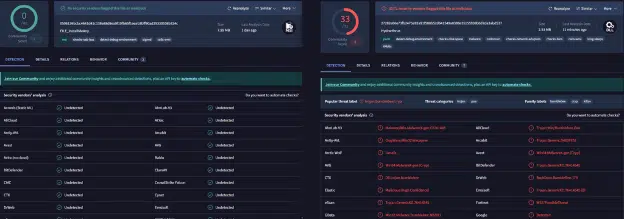Return of Bumblebee Malware Sparks Growing Threat to Supply Chains
May 28, 2025
4 min read
May 28, 2025
4 min read
By Louise Dalton Security Operations Engineer, Origina Security Servicesand Chris Motte Security Threat Intelligence Analyst, Origina Security Services
The resurgence of the Bumblebee malware loader has reignited concerns about the vulnerabilities in software supply chains and the broader implications for enterprise cybersecurity. First discovered by Google Threat Analysis Group in March 2022, this loader is named for its user agent, Bumblebee, which is designed to download and execute follow-on payloads such as ransomware.
Despite a major takedown operation by Europol earlier this year, Bumblebee has returned with a new and troubling tactic: the abuse of RVTools, a legitimate and widely used VMware auditing utility. This development underscores the growing threat of supply chain compromise, where trusted software becomes the unwitting vehicle for cyberattacks.
RVTools is a popular tool among IT administrators for gathering detailed information about VMware environments. It’s free to use, although it is not open source. Originally developed by Robware, it was acquired by Dell in 2023. Its legitimacy and widespread use make it an ideal candidate for abuse by threat actors. In recent attacks, cybercriminals have weaponized RVTools by embedding the Bumblebee malware within its installer or using it as a decoy to mask malicious payloads.
This tactic is particularly dangerous because it leverages the trust organization’s place in known software. When a tool like RVTools is used in an attack, it can easily bypass traditional security filters, which often whitelist such utilities. The result is a stealthy and highly effective method of gaining initial access to enterprise networks, which emphasises the importance of a multilayered, defense-in-depth approach. Knowing the potential path an attacker might take and implementing defenses at crucial points lowers the risks of vulnerability exploit chains and later movement.

Bumblebee is a sophisticated malware loader designed to establish a foothold in compromised systems and facilitate further malicious activity, such as ransomware deployment or data theft. Despite a four-month hiatus earlier this year, the malware has resurfaced and is now using supply chain tactics to evade detection and maximize impact. This includes the download and execution of payloads, DLL injection, shellcode injection, and persistence.
The use of RVTools in this campaign is a stark reminder that no software is immune to exploitation. Even tools designed to enhance security and visibility can become liabilities if not properly vetted, configured, and monitored.
Supply chain attacks are particularly insidious because they exploit the interconnectedness of modern IT ecosystems. By compromising a single vendor or tool, attackers can potentially access hundreds or thousands of downstream targets. The RVTools incident is just the latest example in a growing list of such attacks, which have included high-profile cases like SolarWinds and Polyfill.io.
To defend against threats like the RVTools-Bumblebee campaign, organizations must adopt a proactive and layered approach to cybersecurity. To start, make sure to verify older RVTools installations across your network and check the download history against known clean hashes.
Here are some ways to minimize the risk to your organization.
The exploitation of RVTools by the Bumblebee malware is a sobering example of how even the most trusted tools can be turned against us. As attackers grow more sophisticated, the lines between legitimate software and malicious payloads continue to blur. Organizations must remain vigilant, continuously reassess their trust assumptions, and invest in robust supply chain and security best practices to stay ahead of evolving threats.
A certified CompTIA Cybersecurity Analyst, Louise Dalton previously worked in cybersecurity analysis and response for Hewlett Packard Enterprise. She has a master’s degree in cybersecurity from the National College of Ireland.
Chris Motte has a bachelor’s degree in computer science with a minor in cybersecurity from the University of North Texas. He has experience in the complex breakdowns of vulnerabilities and their effects on everyday products.
Concerned about security risks? Contact the experts at Origina today.
Gain insight into industry-only news, access to webinars, tips and tricks, blog posts, podcasts, and guides, surrounding topics like cybersecurity, reducing software support and maintenance costs and much more, all delivered to your inbox each month.
LEARN MORE